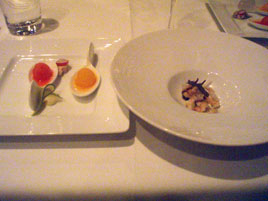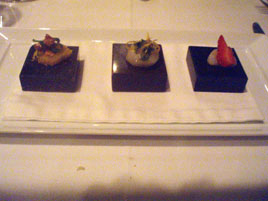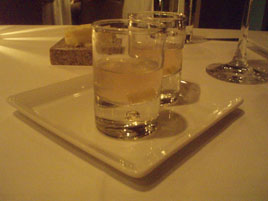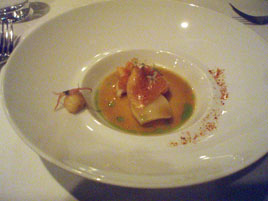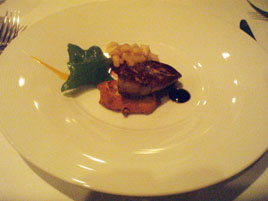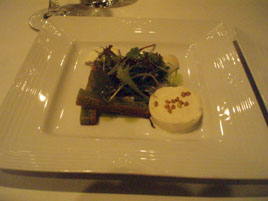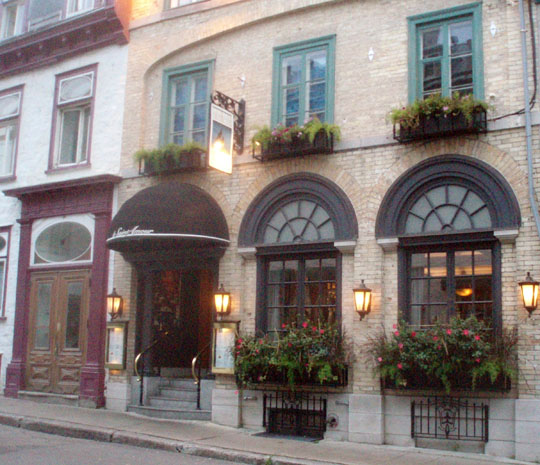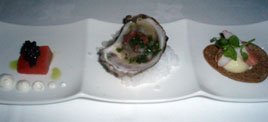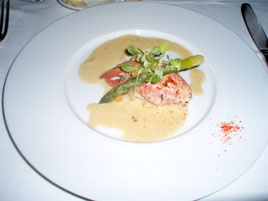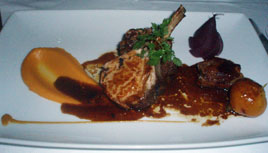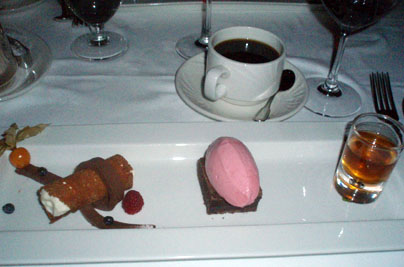Jean Georges
 Wednesday, November 17, 2010 at 04:36PM
Wednesday, November 17, 2010 at 04:36PM 
It took me a while to become a fan of Jean Georges. It’s not that I disliked it; but I didn’t quite get the case for four stars. After my fourth visit, last night, I’m smitten. It’s not that every course was uniformly superb: a couple of items wobbled a bit, and wouldn’t earn four stars on their own. But the experience on the whole is among the best that New York City has to offer.
Although no one goes to a four-star restaurant seeking bargains, it’s worth noting that the four-course prix fixe at Jean Georges ($98) is lower than that of Daniel (three courses, $105), Le Bernardin (four courses, $112), Eleven Madison Park (four courses, $125), or Per Se (nine courses, $275). And Jean Georges was available on OpenTable at 8:00 p.m. on a Tuesday evening with under a week’s notice. The others weren’t.
Vongerichten’s cuisine at its best, interpreted nowadays by Chef de Cuisine Mark Lapico, marries sweet and sour flavors in ways that make you smile. It’s not that no one else has a good crab cake, but no one pairs it with a pink peppercorn mustard and exotic fruits that make such a vivid impression.
I was gratified to see a smattering of wines under $50 — not a ton of them, but you often don’t see any at a place this expensive. At a restaurant like Jean Georges, you are pretty much assured that nothing they serve is plonk. A 2006 Trousseau Lornet from Jura was only $46, and it was one of the most enjoyable wines we’ve had in quite a while. The Jura wines are practically always worthwhile, and because few patrons order them, they’re usually a bargain.
I’m going to keep the food comments to a minimum, and let the photos do most of the talking.


First up was a trio of amuses-bouches (above left) — I believe a black truffle fritter (12:00), fluke sashimi (4:00) and a hot cucumber soup (10:00). Our appetizers were the Santa Barbara Sea Urchin (above right) with jalapeno and yuzu on black bread; and a Jean Georges classic, the Foie Gras Brulee (below left) with fig jam.


As it was my birthday, we sprang for the White Truffle Rissoto ($35pp), which was as intense as any truffle dish I’ve had.


The fish courses were perhaps the best examples of the kitchen’s talent for flavor combinations: the Turbot (above left) with château Chalon Sauce; and the Crispy Crab (above right) with pink peppercorn mustard and exotic fruits.


Parmesan Crusted Organic Chicken (above left) with artichoke, basil, and lemon butter, was just a shade on the dry side, but nevertheless very good. Maine Lobster ($15 supplement, above right) came with perfect black truffle gnocchi and a fragrant herbal broth.


Jean Georges may have the best dessert program of the four-star places, given that each dessert is actually a quartet. We had the Late Harvest (above left) and Chocolate (above right).


The “birthday cake” (more like a flan) was obviously a comped extra; but beyond that was a blaze of petits fours and house-made marshmallows that a party double our size couldn’t have finished.
We were seated at one of the two alcove tables, which the restaurant generally reserves for VIPs or special-occasion guests (I think we were the latter) — clearly the best place to sit, if you can get it. Service was superb.
Jean Georges (1 Central Park West at 60th Street, Upper West Side)
Cuisine: Modern French with Asian accents, beautifully executed
Service: Elegant and luxurious
Ambiance: A comfortable room in soft biege with views of Central Park
Rating: ★★★★

















